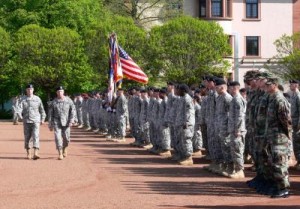 I recently came across this report from BBC News about a U.S. casualty in World War II. The report provides the back-story on the first American casualty in Europe on the eve of the war, made all the more tragic because it was a case of friendly fire. The report is interesting on its own (I can never get enough of those tales of the Greatest Generation), but it also sheds light on a time when the U.S. was making the first tentative plans for the massive troop deployment that would be needed to win that epic war. The airman at the center of the piece was tasked with helping to coordinate planning with Britain to build the facilities and infrastructure needed to accommodate all the U.S. military personnel that would soon visit their shores. This was during the lend-lease era shortly before the U.S. joined the war, a time when the U.S. footprint in Europe was far different than what it would later become.
I recently came across this report from BBC News about a U.S. casualty in World War II. The report provides the back-story on the first American casualty in Europe on the eve of the war, made all the more tragic because it was a case of friendly fire. The report is interesting on its own (I can never get enough of those tales of the Greatest Generation), but it also sheds light on a time when the U.S. was making the first tentative plans for the massive troop deployment that would be needed to win that epic war. The airman at the center of the piece was tasked with helping to coordinate planning with Britain to build the facilities and infrastructure needed to accommodate all the U.S. military personnel that would soon visit their shores. This was during the lend-lease era shortly before the U.S. joined the war, a time when the U.S. footprint in Europe was far different than what it would later become.
Over the succeeding post-war years the U.S. presence in Europe would go on to be quite large, providing the logistical backbone of NATO and serving as an almost unquestioned fact of life in many European countries. That fact of life is now changing. Thanks to looming budget cuts the U.S. presence in Europe is set to change dramatically over the next few years. According to this report in The Washington Post:
The Obama administration has decided to remove two of the four U.S. Army brigades remaining in Europe as part of a broader effort to cut $487 billion from the Pentagon’s budget over the next decade, said senior U.S. officials […] the United States will continue to rotate Army units through Europe on training missions to augment the presence of the remaining two brigades. […] Senior Obama administration officials have targeted Europe for cuts because they recognize that reductions in U.S. forces abroad will generate less congressional outcry than cuts in the United States, where the soldiers pump money into local economies. The U.S. military maintains about 80,000 troops in Europe from all of the services. Cutting two Army brigades and the noncombat units that support them will result in a reduction of about 10,000 to 15,000 soldiers. Panetta’s idea of augmenting American presence around the world by rotating combat brigades or smaller Army units through areas on training exercises is a relatively new concept for the regular Army, which has historically maintained a more static, garrison-based force in Europe.
The U.S. European Command issued this report on the changes in force posture and notes that Germany will be particularly hard-hit by the Army draw-down. Italy will also take a hit as the Air Force closes an air control squadron at Aviano Air Base.
As the above report from The Washington Post notes, U.S. forces are not necessarily leaving Europe, the U.S. is simply transitioning to a new pattern of deployment – rotating deployments – that will keep U.S. personnel as an active, if transient, presence. Still, I can’t help but wonder what effect this will it have on the character and quality of the Western alliance. And it’s not just the reduced number of American personnel but the temporary nature of the deployments that has me worried. I look back fondly on the time I lived in Italy as a military brat, an experience made all the more memorable due to the number of years my family lived there. It was not a temporary duty assignment. And like many Americans stationed there we relished the opportunity to travel the continent and immerse ourselves in the different cultures of Europe as we got to know our NATO hosts. Everywhere we went there was a strong sense of welcome for Americans. In lands rich with history, U.S. sacrifices in WWII have never been forgotten.
It’s true that such things – an appreciation for other cultures and a shared sense of common purpose – are rather intangible. They are certainly difficult to compare with spending cuts. Still, as we debate the harsh realities of budgetary belt-tightening it’s worth discussing what the U.S. might be losing as we strive to draw-down our forces, especially at a time when politicians find it easy to disparage our European allies and certain segments of the electorate drift ever closer to isolationism. There may come a time in the future when we realize that it wasn’t such a bad idea after all to have thousands of Americans living and working side-by-side with our European allies.
Image Credit: New Europe